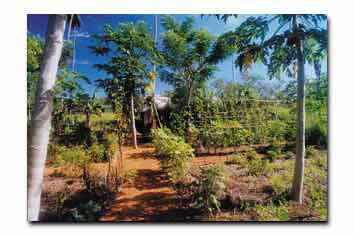Solomon Island
PLANTING MATERIAL NETWORK
Project focus – the early years
The Solomon Islands Planting Materials Network (PMN) was set up to:
- preserve, through use, the agricultural biodiversity of the Solomon Islands
- produce, process and distribute agriculturally useful plants
- provide training in seed saving
- assist rural communities to establish regional seed saving centres.
 Planting Material Network garden, Honiara, Solomon Islands.
Planting Material Network garden, Honiara, Solomon Islands.
The PMN started in 1996 with a series of workshops in the Solomon Islands led by Jude and Michel Fanton from the Seed Savers Network in Australia.
Project duration and funding
Duration: The project started as part of the APACE Kastom Garden Project in 1995 and continues today as an independent non-government organisation registered in the Solomon Islands.
Funding:
- AusAID funding as part of Kastom Garden Project ended in 1998
- .APACE members provided support until AusAID resumed funding in 2000
- in late-2001, funding was secured through the European Union.
The project
The network acts as a clearing house for agriculturally useful seeds. Seeds sourced from farmers are grown and multiplied at seed centres in Honiara and other locations.
Seeds are stored for as short a time as possible so they do not lose their viability. It is the farmer’s gardens that act as the seed bank.
Seed curators manage the entire seed production cycle:
- at harvest, the seed of the most productive and healthiest plants is collected
- the seeds are then dried in the sun or, in the monsoon season, by the heat of a small fire in the seed drying house
- the dried seeds are then stored and tested for germination viability
- members take out seed varieties they would like to try in their gardens and return some of the seed they produce to the Planting Material Network.
- prior to distribution, the stored seed is tested to ascertain the percentage of seed is likely to grow. A classification is assigned and noted on individual seed packets:
- A (90 – 100% viability)
- B (80 – 90% viability)
- C (50 – 80% viability)
- after germination testing, seeds are packaged into small paper envelopes and kept in moistureproof containers with silica gel and wood ash desiccant to absorb moisture in the humid, tropical climate
- the seeds are then distributed to members of the network.
- only non-hybrid seeds are exchanged through the network because – unlike hybrid seeds – they can be relied upon to reproduce true to type, ensuring that successive harvests are productive.
Confirmation that the Planting Material Network was on the right track came in a late 1990s report to UNICEF Pacific by New Zealand consultant, Peggy Fairbairn-Dunlop.
She proposed that seed saving become a part of all the agricultural training activities of development assistance organisations working in the South Pacific to promote food security.
Staffing, training, decentralisation
The network base at Burns Creek, Honiara, was staffed by two young Solomon Island women who were initially trained by Kastom Garden Program manager, Tony Jansen, and project coordinator, Roselyn Kabu.
Mary Timothy and Wendy Betsy soon became competent in running the network and assumed responsibility for the entire seed saving, growing, processing and distribution process.
The decentralisation of the network started in 1999 following the placement of Australian, Emma Stone, with the PMN as a trainer.
The Munda seed centre was established in late 2000 as a response to the worsening internal security situation in the Solomons. Other, smaller seed production locations were started in different provinces.
As the armed conflict of the year 2000 forced seed curators and other staff at the Burns Creek seed centre to evacuate to their home islands for their own protection. The experience emphasised the wisdom of decentralising the PMN, a process that had already started.
New role
In response to the security crisis:
- staff at the PMN’s Burns Creek seed garden expanded the area under cultivation to provide food for refugees pouring into Honiara
- the PMN implemented a project supported by the AusAID Community Peace and Restoration Fund to expand food productions in the home villages of refugees fleeing the conflict on Guadalcanal.
Species
In excess of 100 indigenous and exotic species are conserved by the network.
These include exotics (plants originating outside the Solomon Islands and introduced by missionaries, government, traders, businesses and aid agencies) that have naturalised – that are capable of reproducing in the climatic and soil conditions of the Solomon Islands.
A reason for conserving the seed of indigenous vegetables is that the use of a food plant may decline. Maintaining the plant through the Planting Material Network ensures its survival and availability for reintroduction to the local diet at a later date.
Little need for imports
It was soon after arriving in the Solomons to start the Kastom Garden Project in 1995 that Tony Jansen realised it would not be necessary to import vegetable seeds from Australia.
That was because there were local plants that were:
- equivalent in food value to imported vegetables
- already adapted to the growing conditions – the soils, rainfall and climate – of the Solomon Islands
- known to local people who understood their cultivation, preparation and use.
The future
The PMN is now focusing on two main developments:
- expanding the range of planting materials passing through the PMN by introducing vegetatively-reproduced food plants into the system to supplement those reproduced from seed
- the strengthening of the decentralisation process.
After more than six years of work in the Solomon Islands, the PMN has gained recognition throughout the region for its innovative work.
The PMN was set up as a model capable of replication elsewhere in the South Pacific and South East Asia.

No Comments